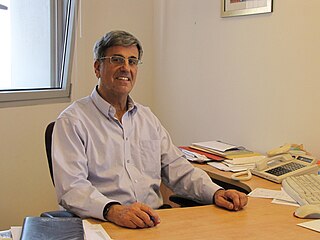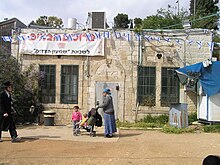
Rehavam Ze'evi was an Israeli general and politician who founded the right-wing nationalist Moledet party, mainly advocating population transfer.

Katamon or Qatamon, officially known as Gonen, is a neighborhood in south-central Jerusalem. It is built next to an old Greek Orthodox monastery, believed to have been constructed on the home and the tomb of Simeon from the Gospel of Luke.

Reuven "Ruvi" Rivlin is an Israeli politician and lawyer who served as the tenth president of Israel between 2014 and 2021. He is a member of the Likud party. Rivlin was Minister of Communications from 2001 to 2003, and subsequently served as Speaker of the Knesset from 2003 to 2006 and 2009 to 2013. On 10 June 2014, he was elected President of Israel. His term ended on 7 July 2021.

Shmuel Eliyahu is an Israeli Orthodox rabbi. He is the Chief Rabbi of Safed and a member of the Chief Rabbinate Council.

The Tomb of Simeon the Just or Simeon the Righteous is an ancient tomb in Jerusalem. According to scholarly consensus, based on an in situ inscription, it is the 2nd-century CE burial site of a Roman matron named Julia Sabina. However, according to a medieval Jewish tradition, is believed to be the burial place of Simeon the Just and his students. It is located adjacent to the Cave of the Minor Sanhedrin in the Shimon HaTzadik settlement within the Sheikh Jarrah neighborhood.

Sheikh Jarrah is a predominantly Palestinian neighborhood in East Jerusalem, two kilometres north of the Old City, on the road to Mount Scopus. It received its name from the 13th-century tomb of Hussam al-Din al-Jarrahi, a physician of Saladin, located within its vicinity. The modern neighborhood was founded in 1865 and gradually became a residential center of Jerusalem's Muslim elite, particularly the al-Husayni family. After the 1948 Arab–Israeli War, it became under Jordanian-held East Jerusalem, bordering the no-man's land area with Israeli-held West Jerusalem until Israel occupied the neighborhood in the 1967 Six-Day War. Most of its present Palestinian population is said to come from refugees expelled from Jerusalem's Talbiya neighbourhood in 1948.

Beit Ya'akov is a small neighborhood in Jerusalem, founded in 1877, the ninth Jewish neighborhood outside the walls of the Old City. The neighborhood borders Jaffa Road and Avishar Road. The Mahane Yehuda Market is located there today.

Nahalat Shimon was a Jewish religious neighborhood of about 40 Jewish families in East Jerusalem in the area currently known as Sheikh Jarrah. It was founded in 1891 by Sephardic and Ashkenazi Jewish Kollels, to house poor Yemenite and Sephardi Jews. The cornerstone of the neighborhood was laid in 1890, near the Tomb of Simeon the Just.

Zion Blumenthal Orphanage is an Orthodox Jewish orphanage and educational institution in Jerusalem. Founded in 1900, it is the oldest active orphanage in Israel.

Shimon Ohayon is an Israeli politician and a professor at Bar-Ilan University. He served as a member of the Knesset for Yisrael Beiteinu between 2013 and 2015.

David ben Shimon also known as Tzuf Devash and the Radvash was a rabbi who headed the North African Jewish community of Jerusalem in the Old Yishuv. Ben Shimon established Mahane Israel, one of the early neighborhoods outside the Old City walls.

Kirya Ne'emana, commonly known as Batei Nissan Bak was a historical Hasidic Jewish neighborhood established opposite Damascus Gate in the New City of Jerusalem in 1875. In the 1880s and 1890s it was joined by additional housing for Syrian, Iraqi, Persian, Georgian, and Caucasian Jews. Most of the residents fled the area during the 1929 Palestine riots and their houses were occupied by Christians and Muslims. In the 2000s a handful of Jewish families reclaimed houses in the neighborhood.

Knesset Yisrael, also known as Knesset, is the name of a group of three former courtyard neighborhoods in central Jerusalem. Known as Knesset Aleph, Knesset Bet, and Knesset Gimmel, the housing project was planned by the Vaad HaKlali Knesset Yisrael and funded by overseas Jewish donors. The houses were completed in stages from 1892 to 1926. Beneficiaries of the housing were poor Haredi Ashkenazi families and Torah scholars connected to the Central Committee kolel system. Today Knesset Yisrael is part of the Nachlaot neighborhood.

Shimon Baadani, also spelled Shimon Ba'adani, was a leading Sephardi rabbi and rosh kollel in Israel. He was the co-founder and dean of Kollel Torah V'Chaim in Bnei Brak, and served as president of dozens of Torah institutions. He was also a senior leader of the Shas political party and a member of that party's Moetzet Chachmei HaTorah rabbinical leadership council.

Even Yisrael is a former courtyard neighborhood in Jerusalem. Built in 1875, it was the sixth Jewish neighborhood to be established outside the Old City walls. It is now part of the Nachlaot neighborhood. In 2004 the neighborhood underwent preservation and renovation by the Jerusalem Municipality, which re-paved and re-landscaped the central courtyard and added a small stone amphitheater for tour groups and daytime passersby.
Yaakov Mutzafi was a rabbi and kabbalist. The last spiritual leader of the ancient Jewish community of Iraq, he moved to Israel ahead of the Jewish masses when they were finally airlifted there in 1952.
Indirect presidential elections were held in Israel on 2 June 2021. The President of Israel is elected by members of the Knesset for a single seven-year term. Incumbent President Reuven Rivlin, who had been in office since 24 July 2014, was ineligible for re-election.

The Sheikh Jarrah controversy, which has been described as a "property/real estate dispute" by the Israeli government and its supporters, and as an "expulsion", "displacement" or "ethnic cleansing" event and a matter of international law by Palestinians and their supporters, is a long-running legal and political dispute between Palestinians and Israelis over the ownership of certain properties and housing units in Sheikh Jarrah, East Jerusalem. The evictions are considered a contributory cause of the 2021 Israel–Palestine crisis.
The 1997–99 Jerusalem stabbings were a series of murders and attempted murders in Jerusalem which primarily took place in and around the Jerusalem neighborhood of Mea Shearim.
The Company for the Reconstruction and Development of the Jewish Quarter is a state-owned enterprise established in 1968 to restore the Jewish Quarter in the Old City of Jerusalem and develop it to become a national, religious, historical, and cultural site. In the 1980s, the company completed the refurbishment and reconstruction of the Jewish Quarter. Although it was supposed to close once its initial goal was complete, as of 2021, the company continues to operate under the jurisdiction of the Ministry of Jerusalem and Heritage.


















